Fergus Garrett has been head gardener at Great Dixter in East Sussex for more than 30 years. For the first 13 years, he worked side by side with Dixter’s owner, the gardener and writer Christopher ‘Christo’ Lloyd, helping to cement Dixter’s reputation as one of the UK’s most innovative gardens. Since Christo’s death in 2006, Fergus has continued to move the garden forward, focused on educating the next generation of gardeners and always eager to experiment. Here, he shares the plants he loves the most.
You may also like
- Christopher Lloyd and the legacy of Great Dixter
- A New South Wales garden inspired by Great Dixter
- A Kent garden inspired by Great Dixter's borders
- 100 beautiful plants and flowers
Jump to
Dear old friends
Often the plants we cherish the most are those that have associations with people and places we’ve loved. These plants fill me with memories of gardening alongside Christo at Great Dixter.
Campanula pyramidalis
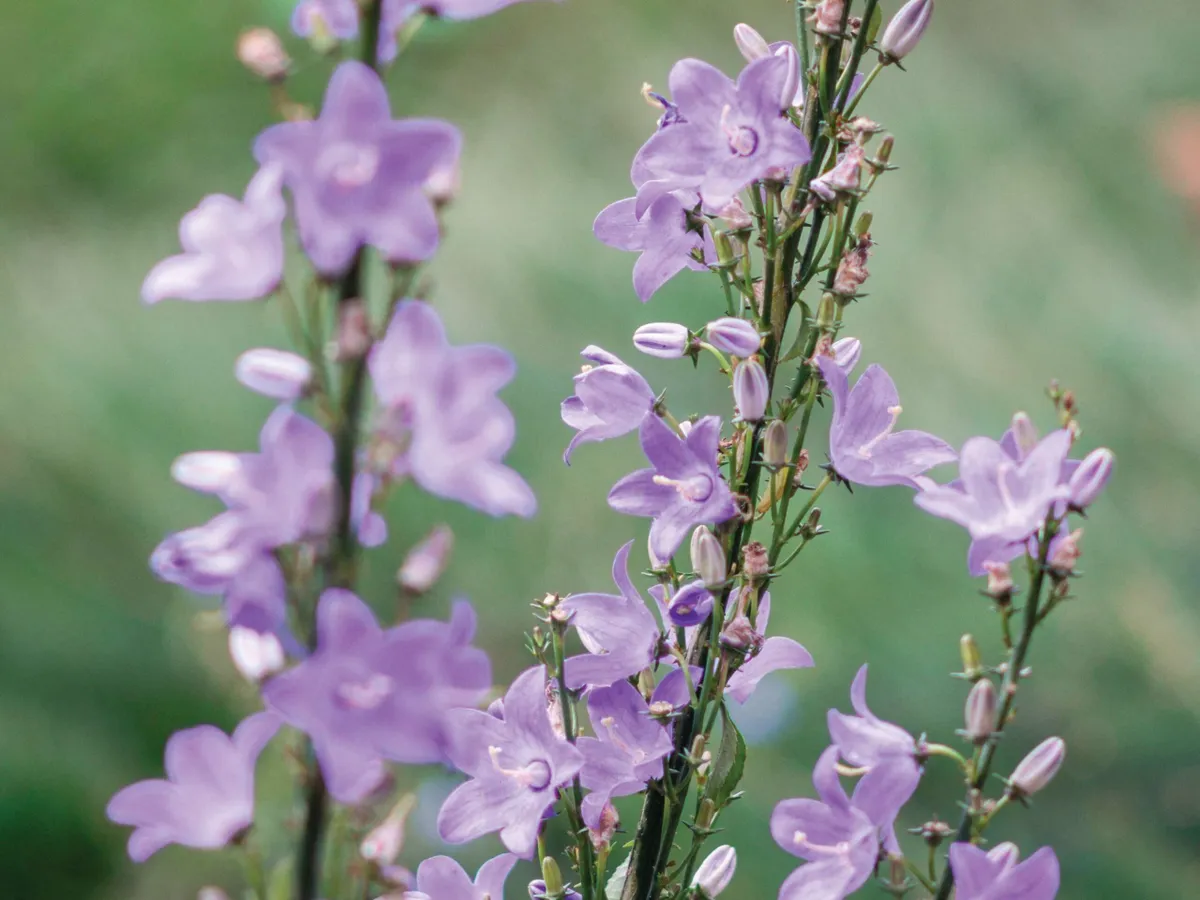
The chimney bellflower was used by the Victorians for spectacular indoor displays. Sown in April and potted on to make large rosettes, it will, in the second year, give rise to several tall stems densely packed with mauve, star-shaped flowers, opening wide to reveal paler centres and a prominent pistil. A short-lived perennial best treated as a biennial. White and pink forms are available. Flowers for longer when brought inside.
Height (H) 2m. Spread (S) 60cm. Plant type (PT) Perennial. Conditions (C) Moist but well-drained soil; full sun to part shade. Season of interest (SI) June – August. Hardiness rating (HR) RHS H4, USDA 7a-11.
Here's more on how to grow campanula
Chimonanthus praecox
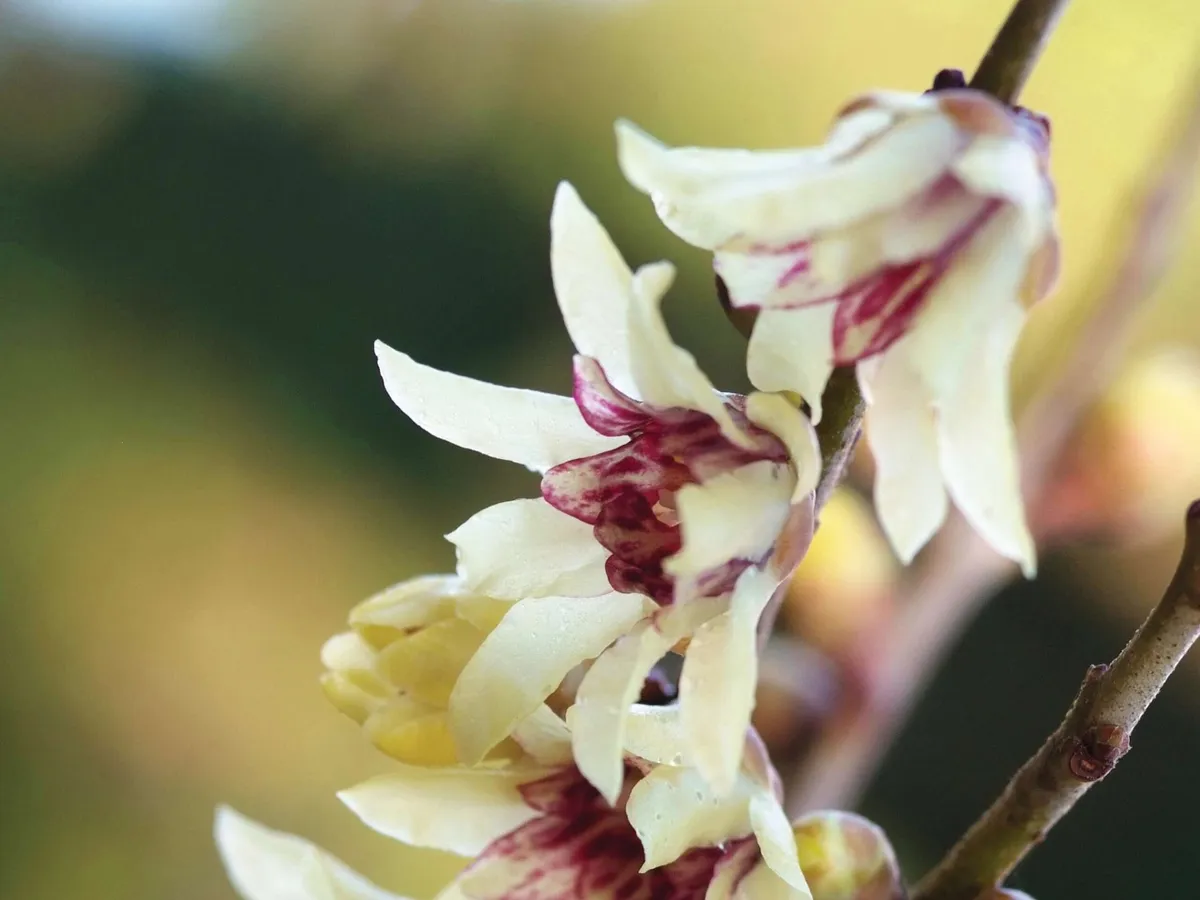
The wintersweet has a hypnotic quality unequalled by any other shrub. Dull for most of the year, it sheds its leaves to reveal a zig-zag of skeletal stems which, as winter progresses, develop fat buds. They open in December into sweetly scented, translucent pale-yellow flowers, each with a murky, wine-coloured centre. Has an overall twiggy appearance and an inexplicable charm.
H 3m. S 3m. PT Shrub. C Moist but well-drained soil; full sun. SI December – January. HR RHS H4, USDA 7a-9b.
Crataegus ellwangeriana

A seldom-seen North American species that is rare in the wild. It’s a small tree with an elegant, rounded habit, with large oval-shaped, serrated leaves. Carries clusters of off-white flowers in the spring, followed by substantial bright-red fruit lasting well into the autumn, as foliage turns golden yellow before leaf fall.
H 4m. S 4m. PT Tree. C Any soil; full sun to part shade. SI Flowers spring; berries and foliage autumn. HR USDA 4a-8b.
Erigeron karvinskianus
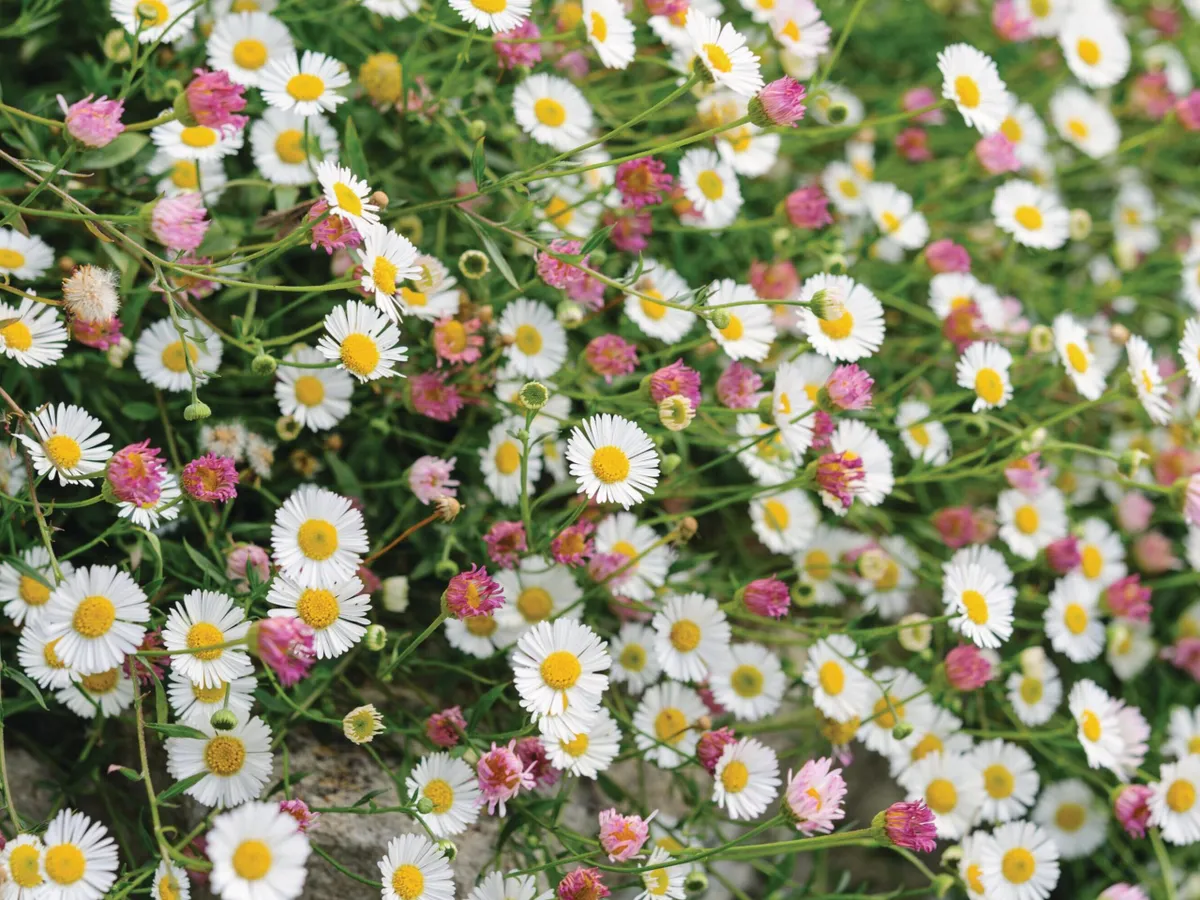
A plant well known to many, but still worthy of a place on this list. The Mexican fleabane gives a profusion of pale-pink and white daisies over a long period. It flowers all summer long, self-seeds in cracks and walls, it’s useful in pots, and in bedding, drought resistant and resilient. Plants should be sheared back to the base once or twice a year.
AGM. H 30cm. S 30cm. PT Perennial. C Well-drained soil; full sun. SI June – October. HR RHS H5, USDA 6a-9b.
Geranium ‘Ann Folkard’
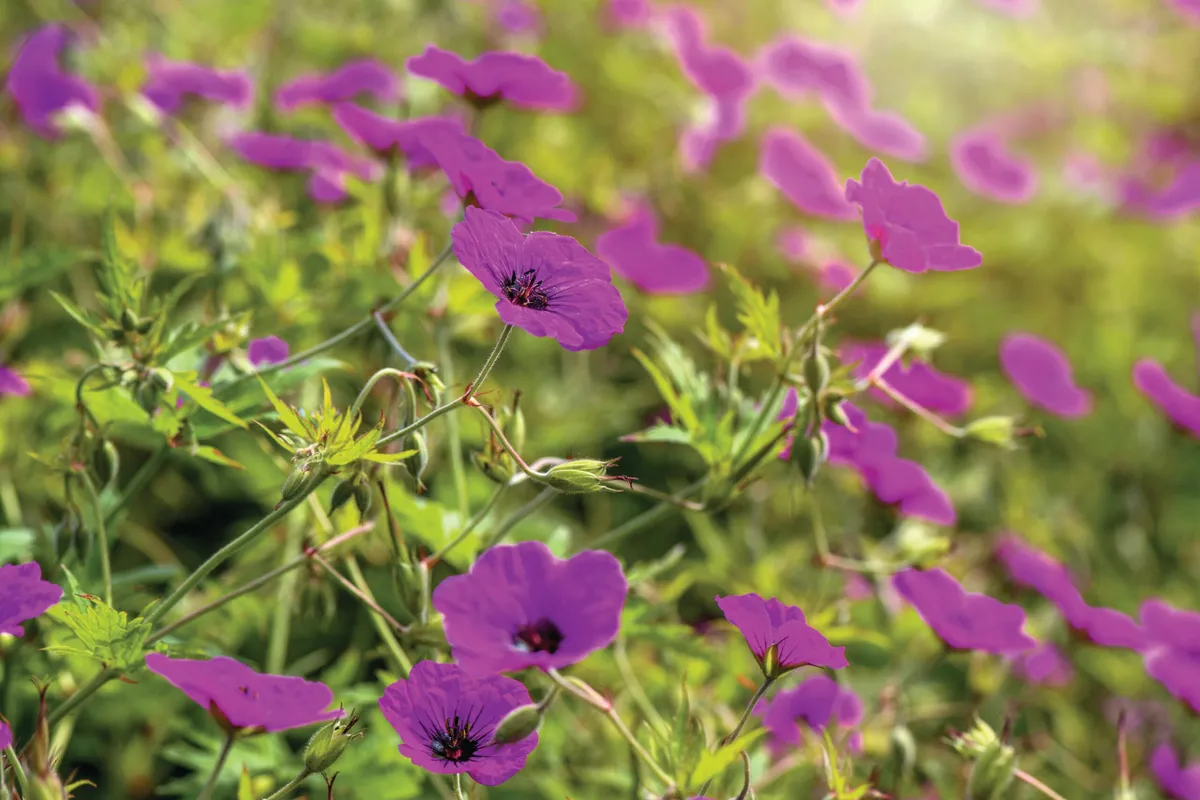
A hardy, free-flowering perennial geranium with a trailing habit. The foliage in spring is lime green. Dark-centred magenta flowers are produced on the tips of the stems from July to the end of September. The plant can roam freely, trailing into its neighbours, or can be contained into a clump using pea sticks. Cut down to the ground before winter.
AGM. H 75cm. S 60cm. PT Perennial. C Moist but well-drained soil; full sun to part shade. SI July – October. HR RHS H7, USDA 6a-8b.
Narcissus ‘Baby Boomer’

Christo was very fond of jonquils and this one is the closest I can find to his mother’s original plant. A delicate multi-headed daffodil with narrow, rush-like leaves and upright stems carrying up to five or six small, fresh-yellow, highly scented flowers in early spring. Very good in pots or integrated among perennials in the border.
H 40cm. S 20cm. PT Bulb. C Moist but well-drained soil; full sun to part shade. SI April. HR RHS H6, USDA 7a-9b.
Here's our guide on growing daffodils
Olearia solandri
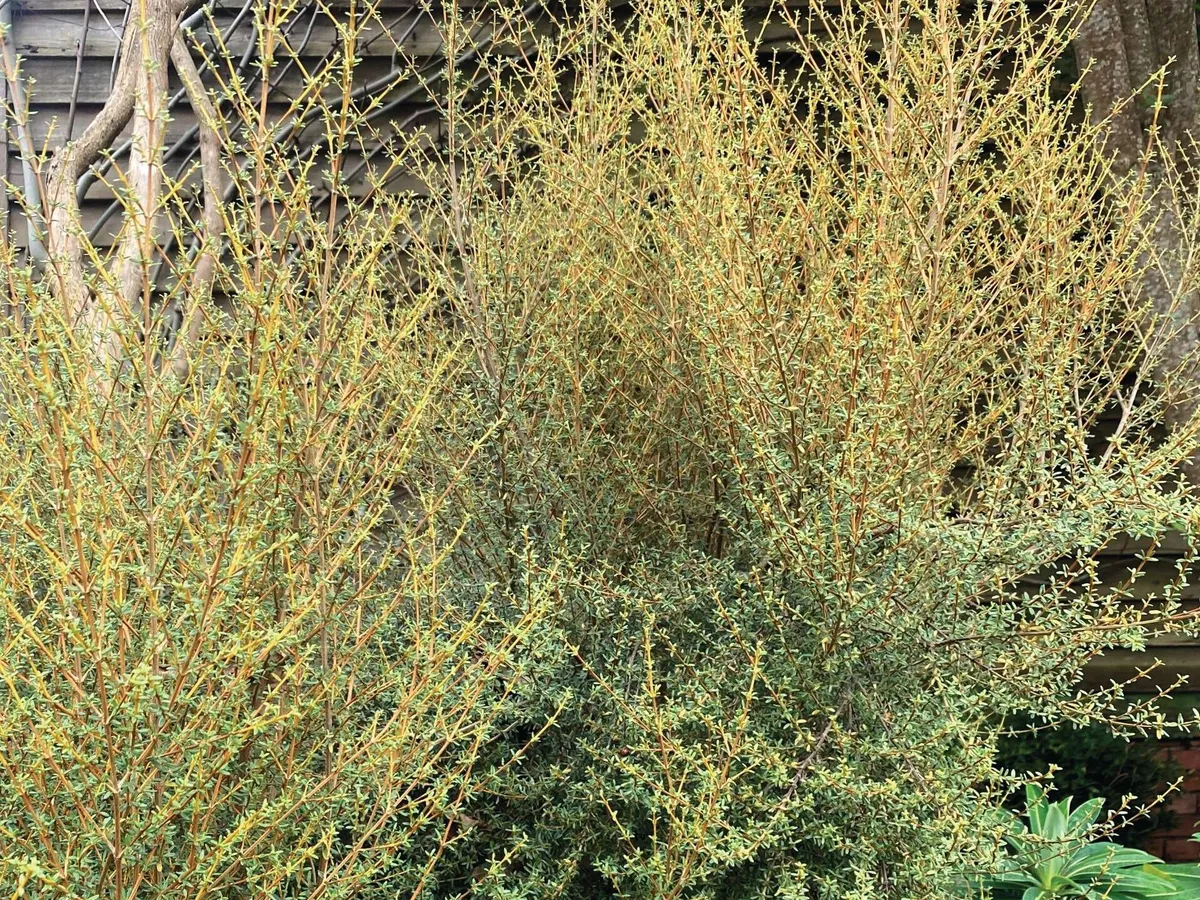
The coastal daisy bush will not stop you in your tracks initially, but once you analyse its qualities, you realise what an extraordinary plant it is. Evergreen, with an upright, bushy habit, with dense coverings of brownish, olive-green, heather-like leaves, and the young growth lighter in colour, this plant has a great texture. The flowers are insignificant and occasionally scented of heliotrope.
H 4m. S 3m. PT Shrub. C Moist but well-drained soil; full sun to part shade. SI Year round. HR RHS H4, USDA 7a-9b.
Paulownia tomentosa

The foxglove tree is native to central and western China, where it grows to over 25m high, making a large dome and flowering in early spring with scented, long, tubular, mauve flowers. When stooled to 10cm from the ground, the plant puts all its energy into producing 3-4m tall, upright stems with gigantic leaves, without the flowers. Invasive in the wrong place.
AGM. H 4m. S 1m. PT Tree. C Tolerant of a wide range of soils; full sun. SI Foliage: June – November; flowers: spring. HR RHS H5, USDA 5a-8b.
Peucedanum verticillare
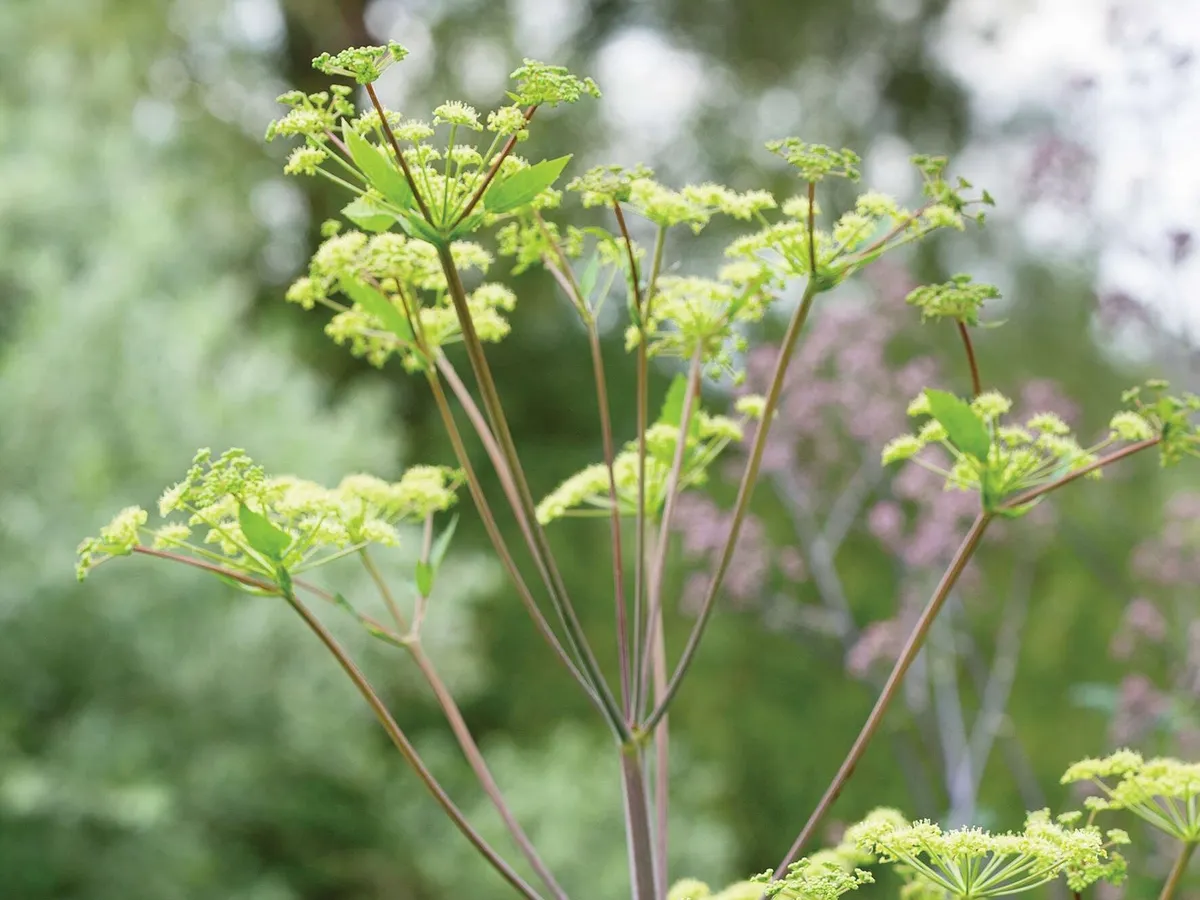
A stylish monocarpic umbel with broad celery-like leaves that are flushed brown when young, turning green with age. Upright, tall, dark stems carry whorls of flat-headed, mustard-yellow flowers. Self-seeds. Makes a stunning, solitary, architectural feature especially when rising above its surroundings.
H 2.5m. S 50cm. PT Monocarpic herb. C Moist but well-drained soil; full sun to part shade. SI Summer. HR RHS H7, USDA 6a-8b.
Polypodium x mantoniae ‘Cornubiense’
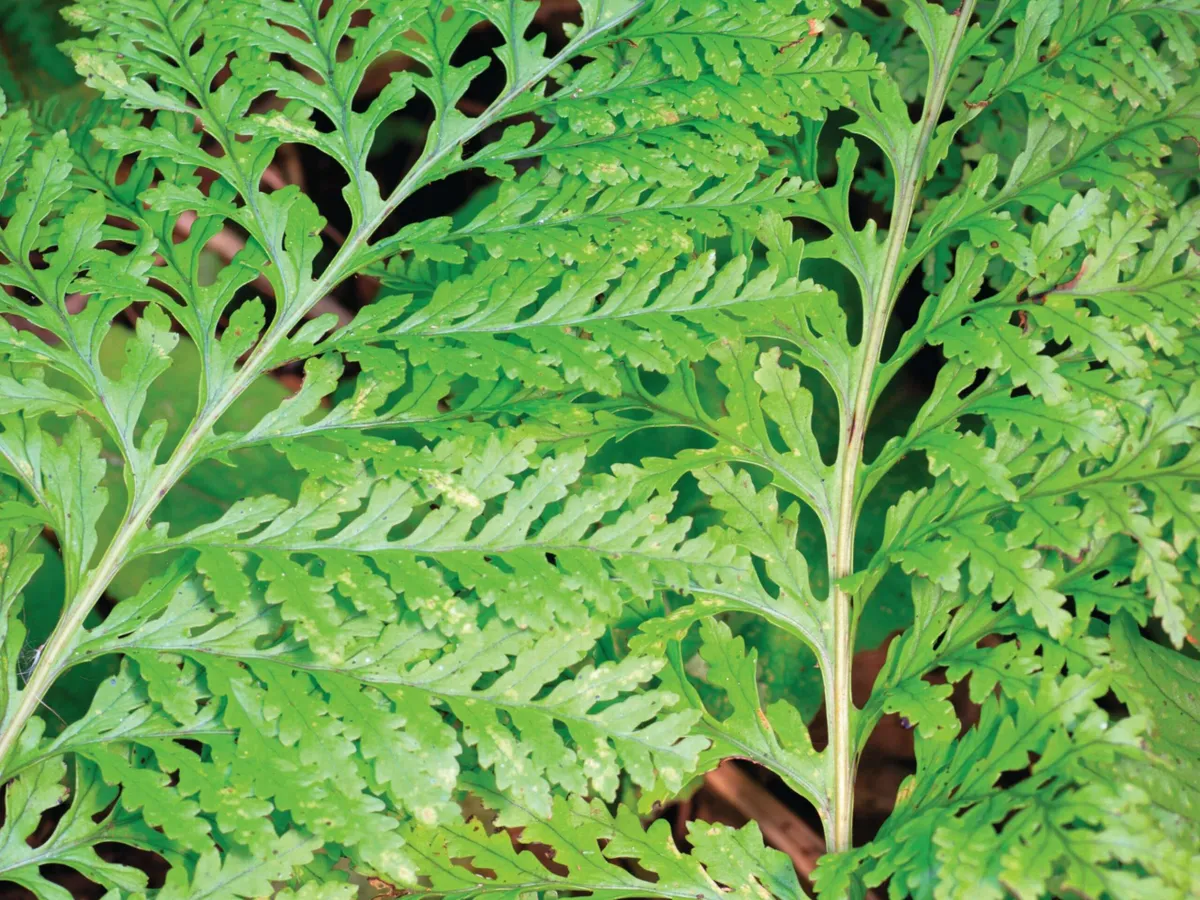
All polypodies are useful, being wintergreen when so many plants around them are dormant. This one has fresh-green, lacey foliage that is finely cut and broadly ovate at ground level, with a slowly colonising creeping habit. Sometimes simpler, less finely cut leaves are produced. Grows best in moist shade, as long as it’s not waterlogged. Lovely with Cyclamen hederifolium and snowdrops.
AGM. H 30cm. S 30cm. PT Fern. C Moist but well-drained soil; full sun to part shade. SI Year round. HR RHS H6, USDA 5a-9b.
Here's more on great ferns for your garden
Verbascum olympicum
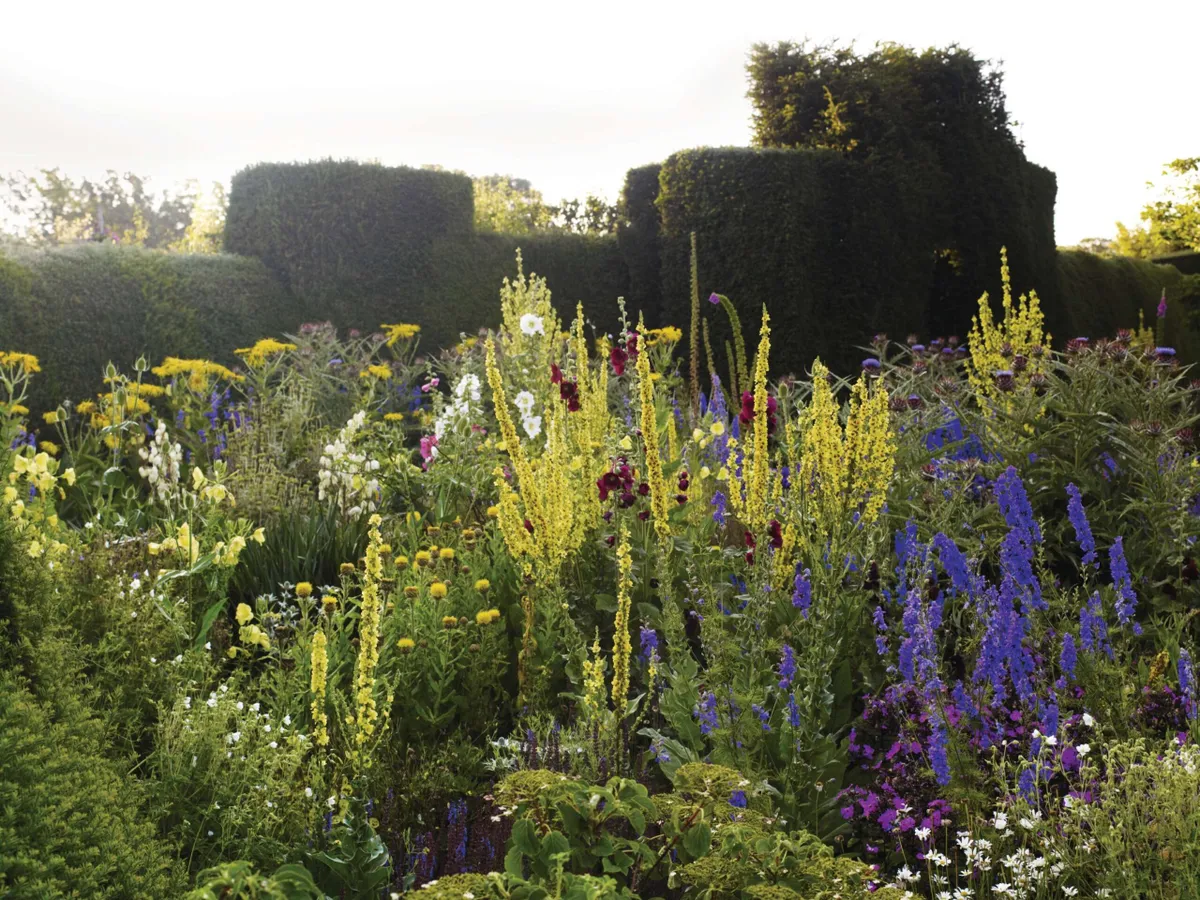
The most impressive of all verbascums, with huge rosettes of hairy grey-green leaves. In May, it pushes up a skyrocket of a stem that metamorphosises into a huge branching candelabra, carrying bright-yellow flowers in June and July, creating dramatic accents in the border. After flowering, it sets seed and dies, the young seedlings taking two to three years to reach flowering size.
H 2.5m. S 60cm. PT Biennial. C Light, well-drained soil; full sun. SI June – August. HR RHS H6, USDA 5a-9b.
How to grow verbascums in the garden
Garden stalwarts
Every garden relies on stalwart garden plants that do the work for you and never let you down. These are the plants I wouldn’t want to garden without.
Asarum europaeum
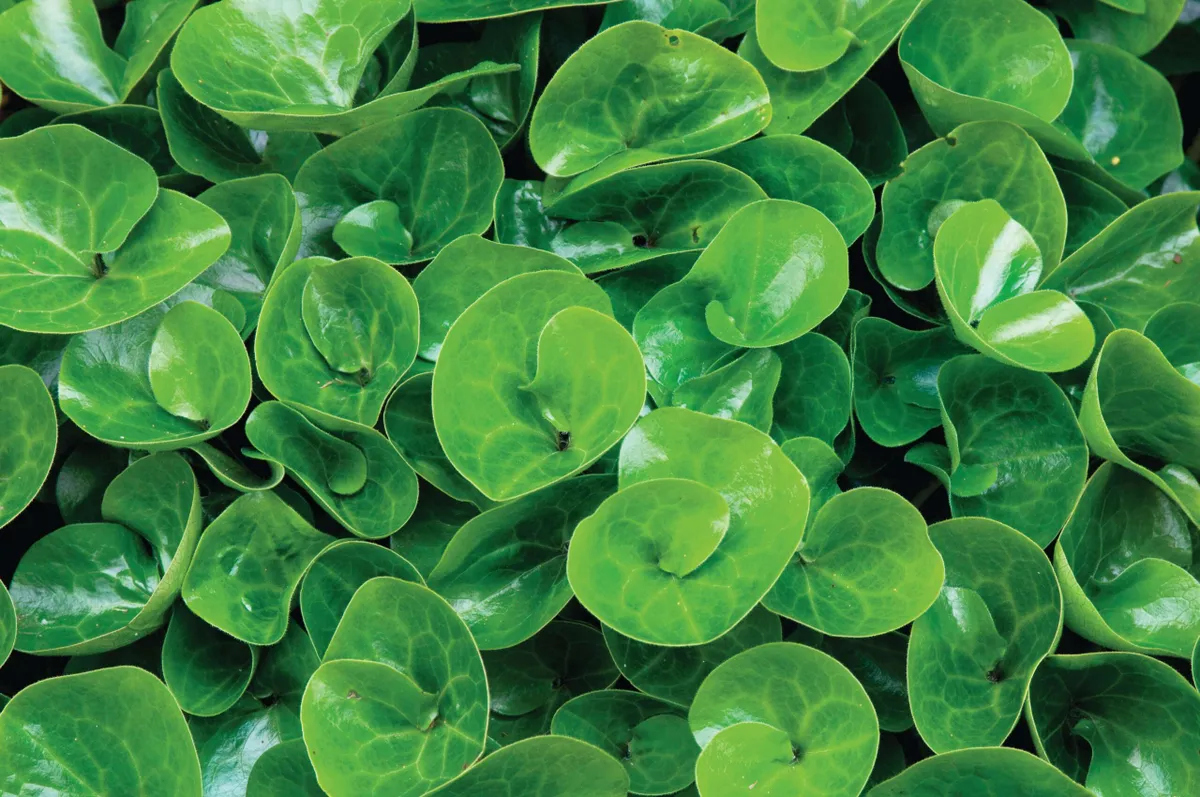
The European wild ginger is a creeping, ground-covering, evergreen perennial with a wide distribution across temperate Europe, occurring in deciduous woodland and coniferous forest. It has glossy, dark-green, kidney-shaped leaves with brownish-maroon, solitary, fused flowers in late winter and spring. Tolerant of shade, Asarum can be planted as an understorey to many perennials, taking centre stage as the perennials retreat.
H 15cm. S 20cm. PT Perennial. C Soil rich in organic matter; full shade. SI Year round. HR RHS H4, USDA 7a-9b.
Consolida ‘Sublime Lilac’
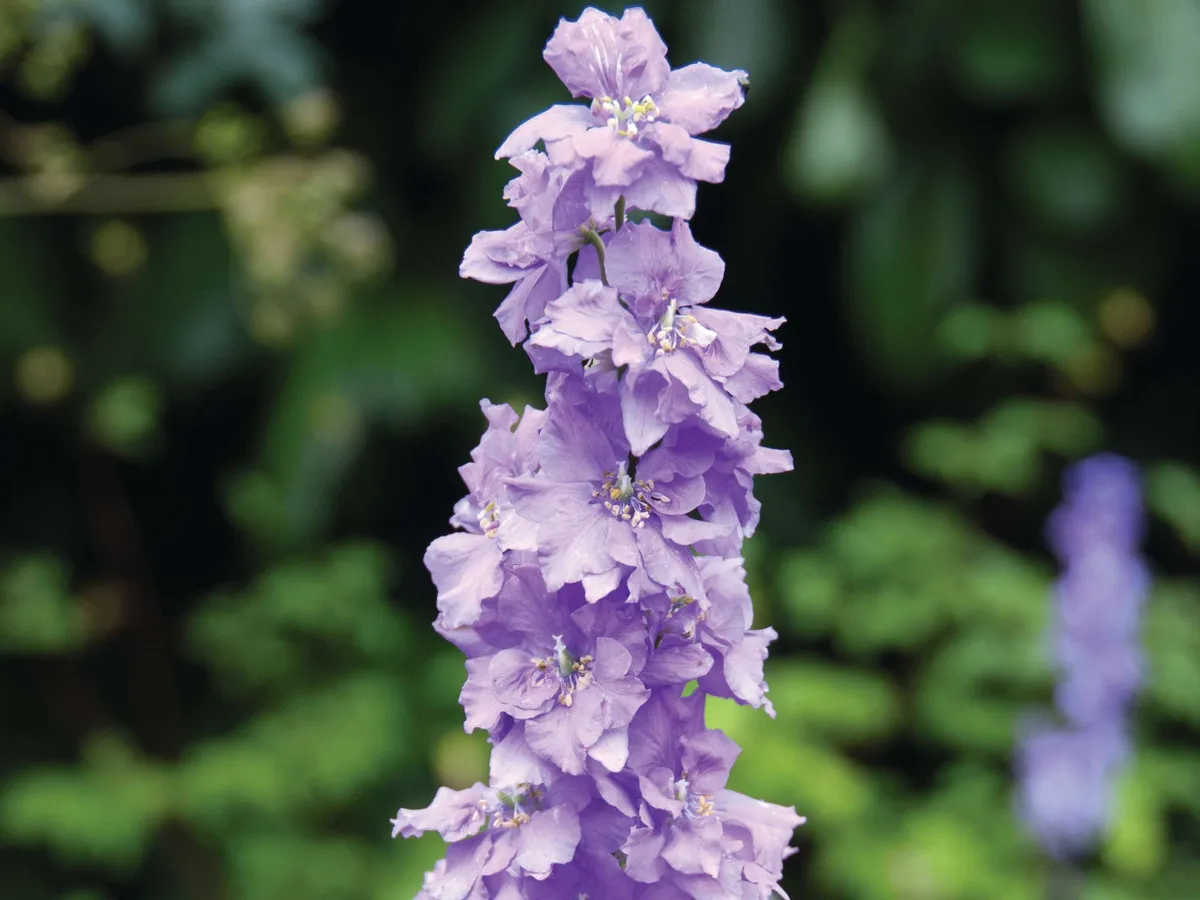
A tall and upright annual with feathery lace-like leaves and narrow spikes of delightful, mauve, double, long-spurred flowers. Sown in autumn and planted out in March, we use it threaded through the borders, flowering in June and July, giving useful colour before the summer flowers arrive. Makes an excellent cut flower.
H 1.5m. S 30cm. PT Annual. C Moist but well-drained soil; full sun. SI July – September. HR RHS H5.
Cryptomeria japonica Araucarioides Group
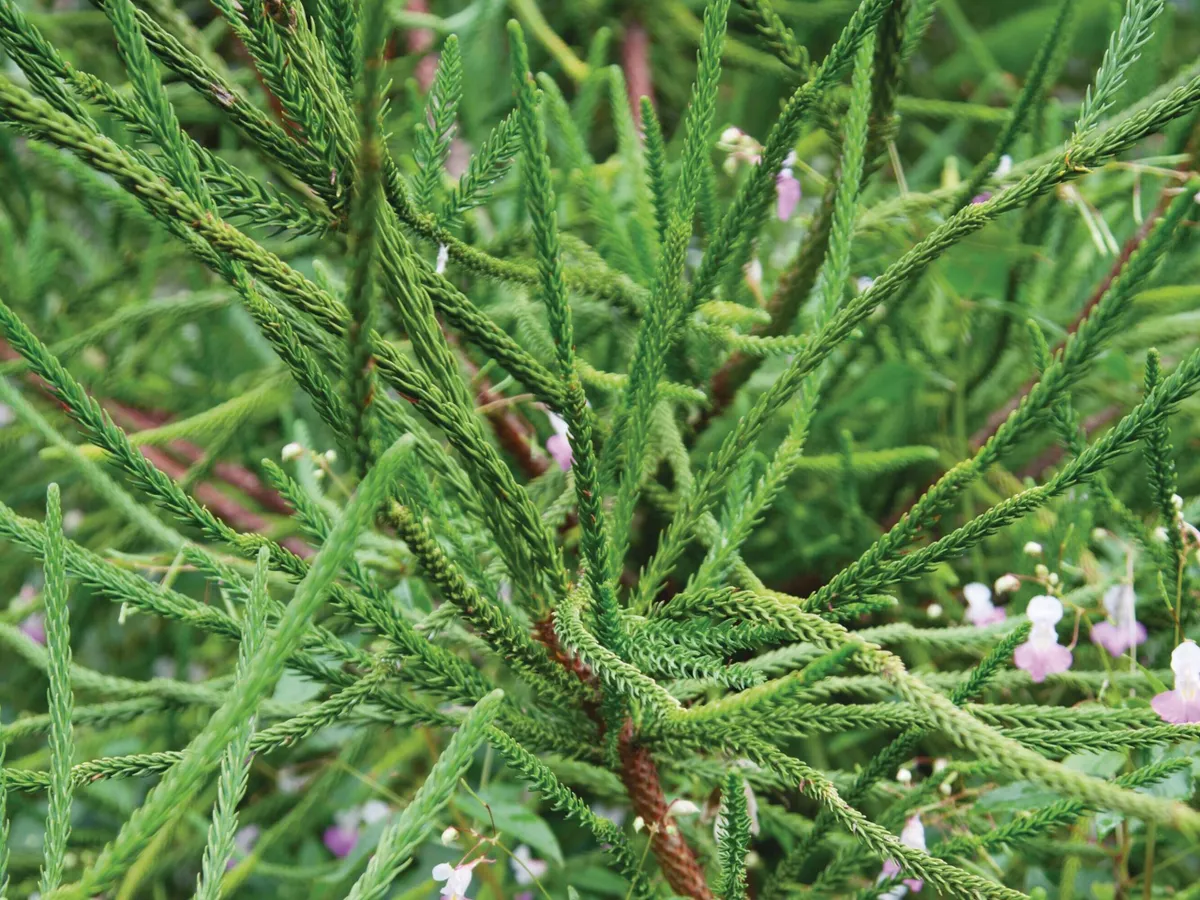
An ungainly tree of great character with reddish-brown bark and an open habit. Has long branches that twist and turn, with stems covered in short, dark-green, sickle-shaped needles pressed tight around the wood, resulting in a prickly cord-like structure. Has the feel of a monkey puzzle but finer in many ways. Makes a great feature when mixed with broader-leaved plants.
H 6m. S 4m. PT Tree. C Well-drained soil; full sun. SI Year round. HR RHS H5, USDA 6a-9b.
Euphorbia characias subsp. wulfenii
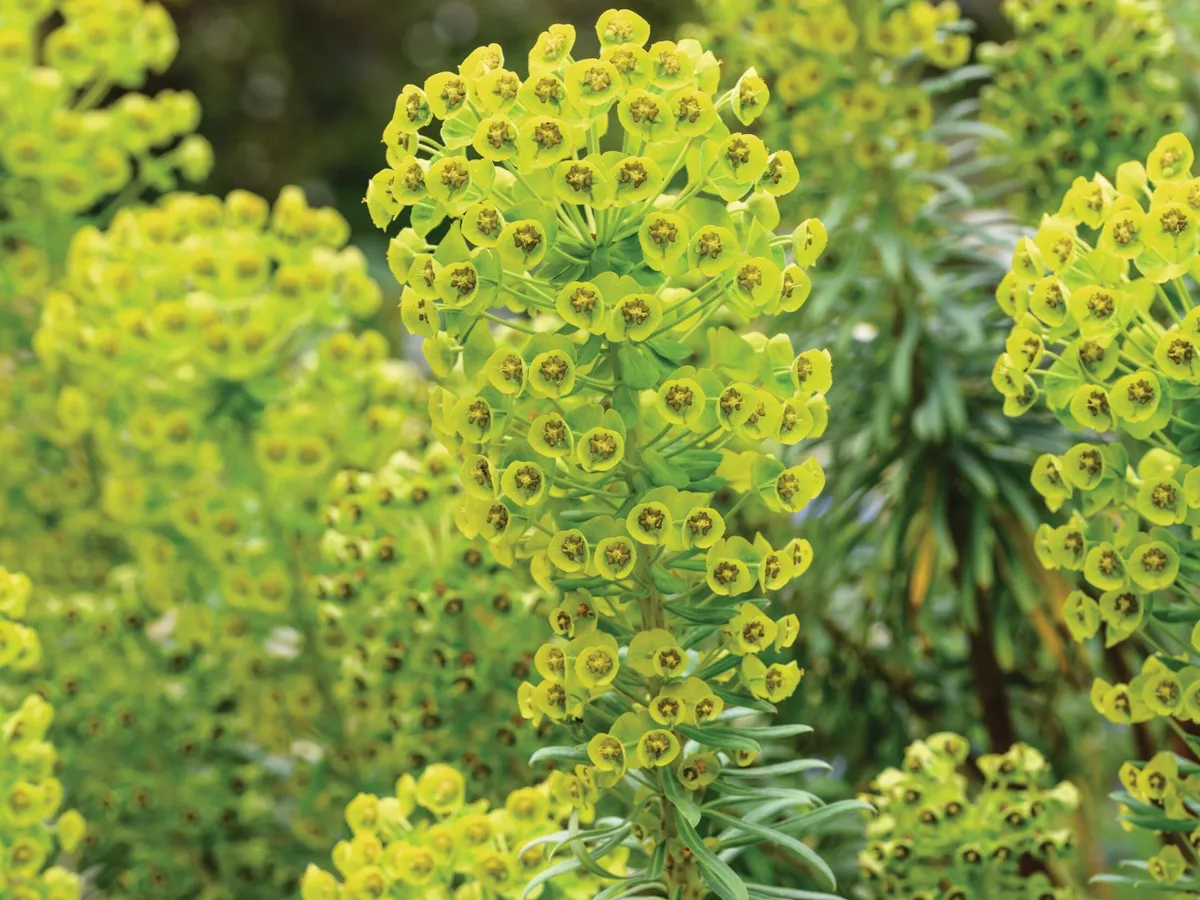
A common, first-class garden plant with whorls of grey-green leaves, making a rounded evergreen bush. Bold heads of lime-green flowers are produced on the mature stems, which can be cut away as the flowers fade. New shoots will replace the old ones and new seedlings will replace old plants. Flowers from spring into summer, making dramatic points of lime-green throughout the garden.
H 1m. S 75cm. PT Sub-shrub. C Well-drained soil; full sun. SI Foliage: year round; flowers: March – May. HR RHS H4, USDA 6a-8b.
Here's more on growing euphorbia
Galanthus plicatus ‘Augustus’

The pleated snowdrop from eastern Europe has broad, bluish, grey-green leaves characterised by folded-over leaf edges, a distinctive midrib and residual markings, giving it a pleated look. The nodding white flowers are held on short stems, with the inner segments marked green, and arrive at the end of February. The form ‘Augustus’ is chunky and bold, making quite a show when planted en masse.
AGM. H 15cm. S 15cm. PT Bulb. C Moist but well-drained soil; full sun. SI February – March. HR RHS H5, USDA 3a-7b.
Here's more on planting snowdrops in the green
Luma apiculata ‘Glanleam Gold’
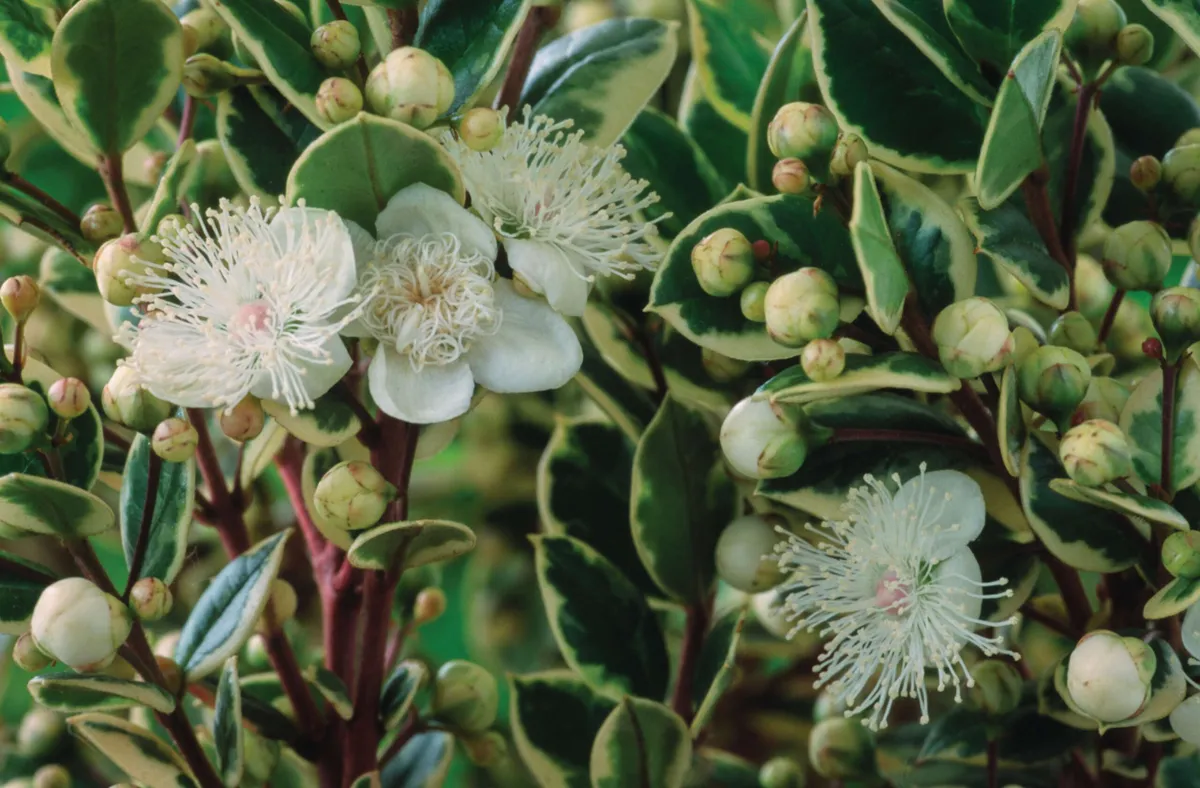
An evergreen shrub or small multi-branched tree with attractive reddish bark, small dark-green leaves edged with yellow markings, and clusters of white flowers in summer. Makes a great foliage feature in the border, contrasting with neighbouring grasses. Prefers full sun or semi shade, is slow growing and needs no regular pruning.
H 4m. S 2m. PT Shrub. C Well-drained soil; full sun to part shade. SI Foliage: year round; flowers: June – October. HR RHS H4, USDA 8a-9b.
Looking for more evergreen shrubs?
Miscanthus sinensis ‘Malepartus’
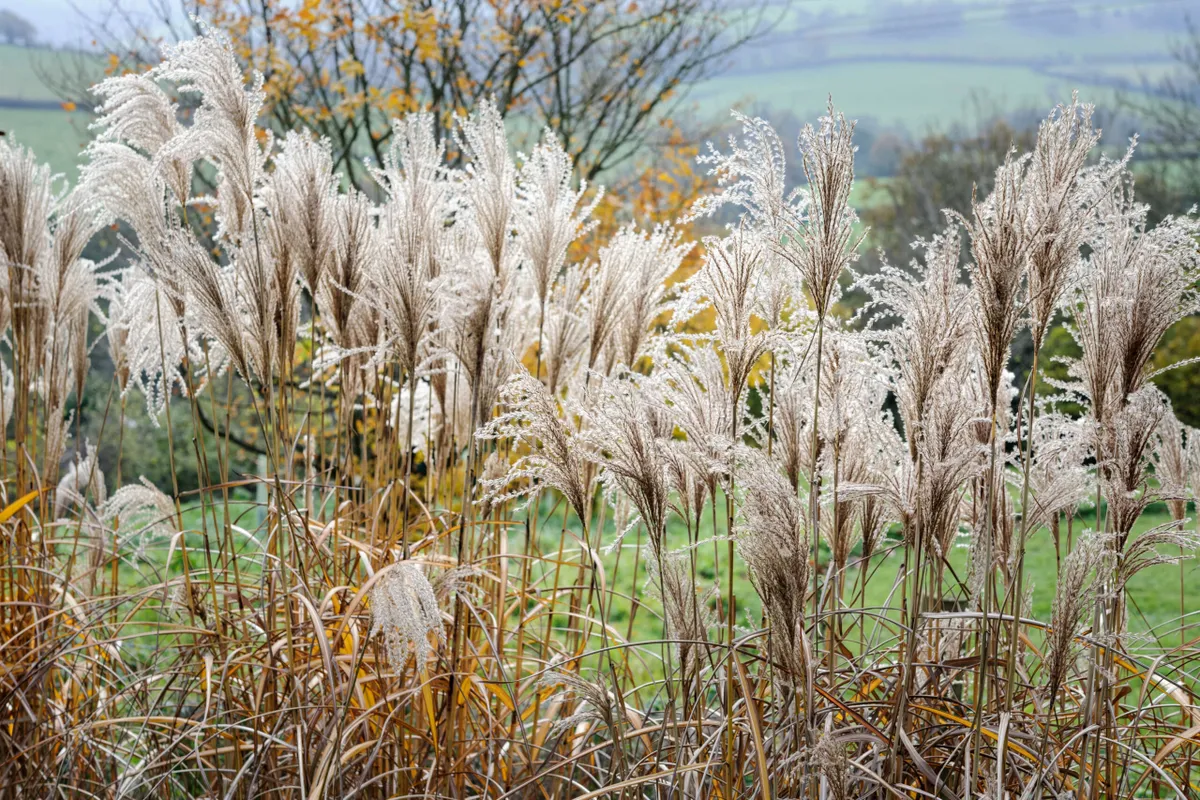
A medium-sized upright grass with a neat composition, flowering late in September, with feathery plumes rising well above the foliage. Autumn colours of burnt oranges and yellows follow before the whole plant turns brown for the winter. Makes a good shape contrast to all the domes in a mixed border. Cut down in late winter or early spring.
H 2m. S 50cm. PT Grass. C Tolerant of a wide range of soils; full sun. SI Flowers: August – November. HR RHS H6, USDA 4a-9b.
Here's how to grow and care for miscanthus
Papaver commutatum ‘Ladybird’
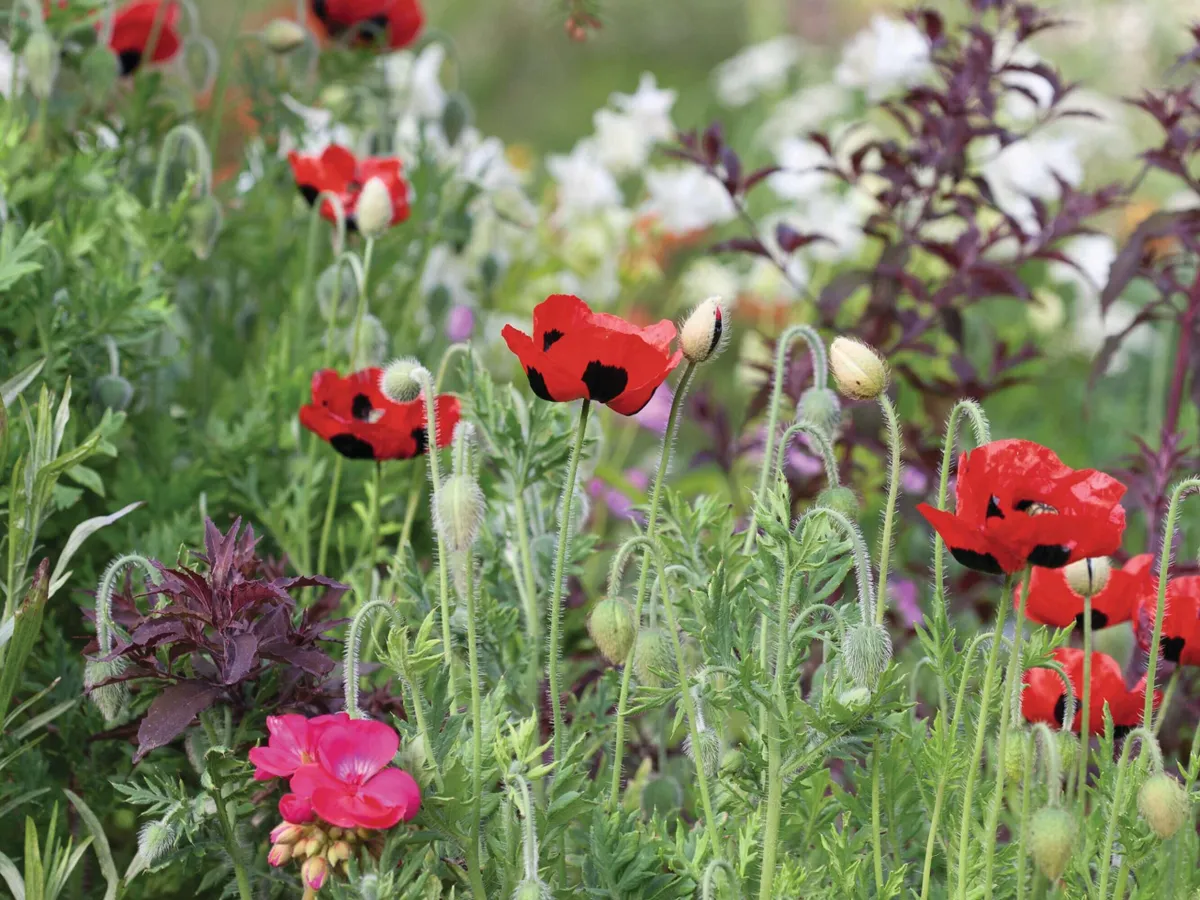
Nothing quite brings in the summer like a ladybird poppy. Bright-red flowers, each petal boldly dressed with a black blotch at its base, nodding buds and finely lobed leaves make it a vibrant garden plant. We autumn sow, prick out and then plant through the borders randomly at high density and low density to make seams of red through all the open spaces.
AGM. H 45cm. S 30cm. PT Annual. C Well-drained soil; full sun. SI June – August. HR RHS H5.
Ulex europaeus ‘flore pleno’
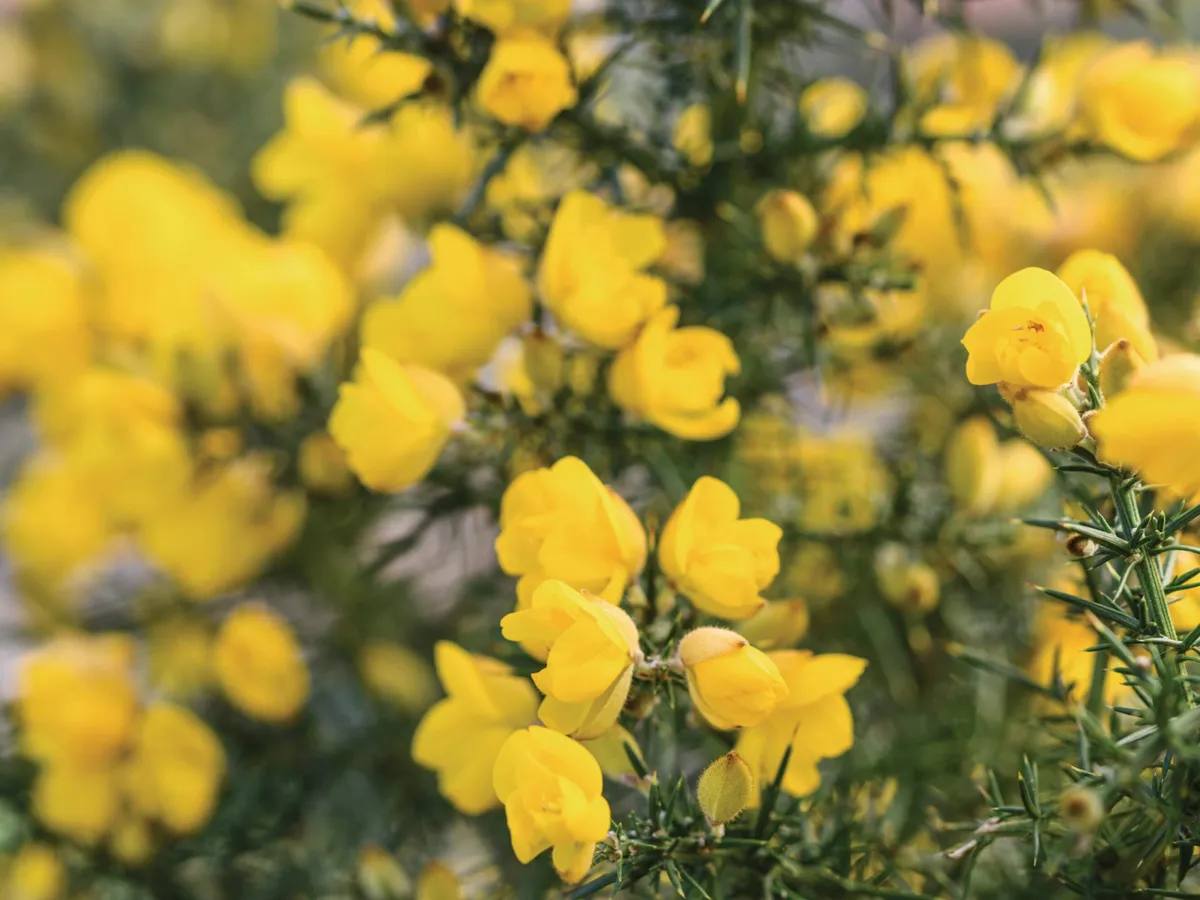
This double gorse flowers its heart out throughout the year with golden-yellow flowers that are sweetly scented of coconuts. It has an interesting texture and an undulating, upright, pointing habit on a rounded bush, with spine-tipped stems and spiny leaves. Plants can be cut back once they get too big and they will sprout readily from old wood.
AGM. H 1.5m S 1.5m. PT Shrub. C Tolerant of a wide range of soils; full sun. SI March – November.
HR RHS H6, USDA 6a-9b.
Great for mixing in
These plants may not fit into the other categories, but are ones that add another dimension to the ones already chosen – they have a life and a purpose of their own.
Adiantum venustum
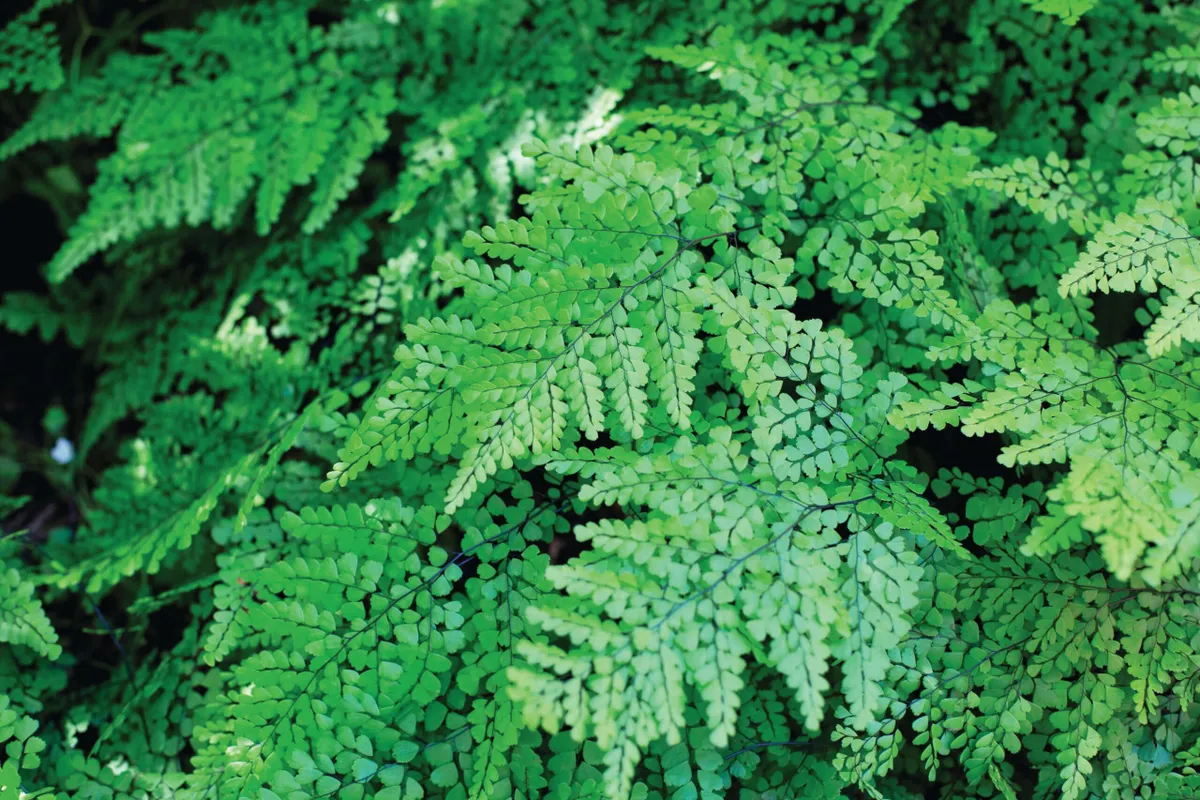
The Himalayan maidenhair fern is a hardy evergreen fern that has finely divided, triangular fronds that are dainty and lace-like, carried on black stems with an overlapping habit. Slow to increase, it does best in moist conditions in soil that is rich in organic matter. Tolerant of deep deciduous shade, it will sit under shrubs and perennials, covering the soil.
AGM. H 20cm. S 40cm. PT Fern. C Moist, organic-rich soil; part to full shade. SI Year round. HR RHS H7, USDA 3a-8b.
Wondering how to propagate ferns?
Begonia soli-mutata

A ground-hugging, tender begonia with rounded obovate, dark-green, almost brown, leaves; deeply veined and heavily textured, glossy and with a rough surface. The flowers are small and white and held in loose clusters in panicles above the foliage. Makes layers of foliage flushed with brown and a perfect foil to ferns. Easy from cuttings. Needs greenhouse cover for the winter but enjoys being planted out for the summer.
H 30cm. S 50cm. PT Perennial. C Moist organic-rich soil; part shade. SI Year round. HR RHS H1B, USDA 9a-11.
Here's more on growing and caring for begonias
Clematis x aromatica
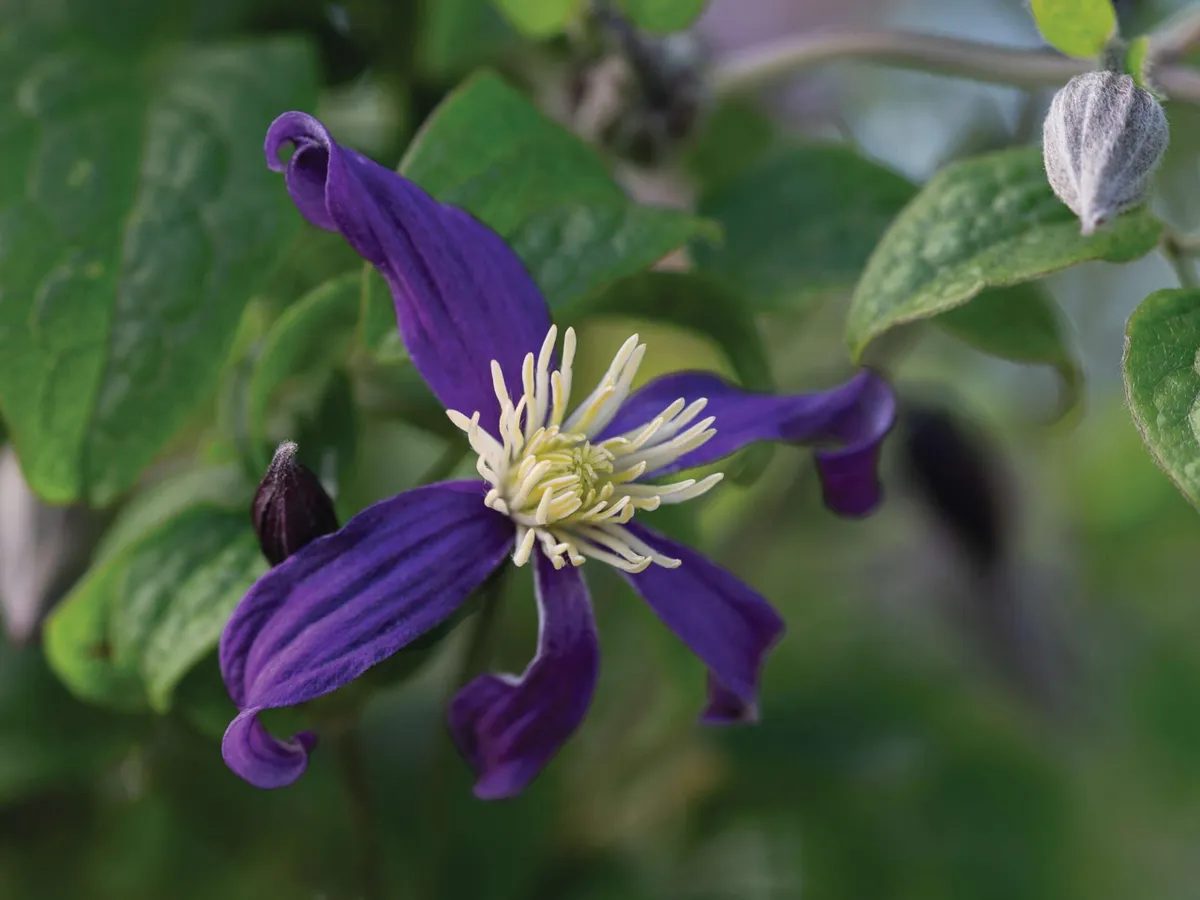
A hybrid between Clematis flammula and Clematis integrifolia with deep-purple, star-shaped flowers that are 4cm across with an emboss of bold creamy-white stamens. The flowers are strongly scented, blooming from July to September. Of moderate vigour, making a useful garden plant scrambling through small shrubs such as roses and weigelas.
H 2m. S 1m. PT Climber. C Moist but well-drained soil; full sun. SI July – September. HR RHS H6, USDA 5a-9b.
Here's some herbaceous clematis to grow
Euphorbia x pseudovirgata
A hybrid between Euphorbia virgata and Euphorbia esula resulting in a somewhat invasive spurge, with airy, grey-green foliage and a running rootstock scrambling through vegetation, coming alive with bright, lime-green flowers over a long period. Its running nature can be used to your advantage, as it colonises areas without squeezing other plants out, filling the open spaces and threading acid green through other colours.
H 1m. S 30cm. PT Perennial. C Tolerant of a wide range of soils; full sun. SI Year round; flowers: July – October. HR RHS H4, USDA 6a-8b.
Here's more on caring for euphorbia
Lathyrus rotundifolius
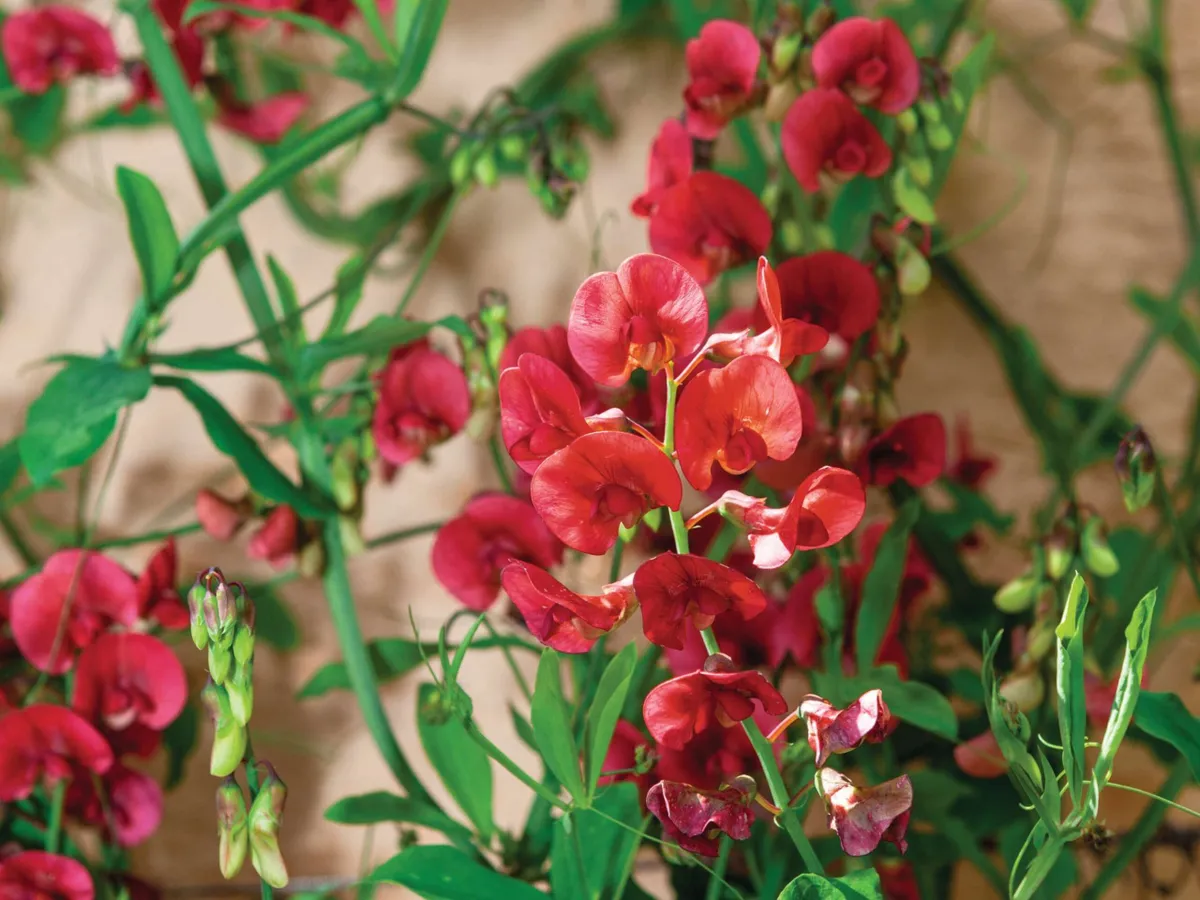
A medium-sized, delicate perennial sweet pea with petite, rounded leaves on slender stems and clusters of small, brick-red, unscented flowers. Clinging tendrils help this pea work into its surroundings, and in the wild it is often seen as a plant of high meadows, scrambling up vegetation. Can be propagated from seeds sown in the autumn or early spring.
H 1.5m. S 30cm. PT Perennial. C Tolerant of a wide range of soils; full sun to part shade. SI June – August. HR RHS H7, USDA 3a-8b.
Here's how to grow sweet peas
Thalictrum ‘Black Stockings’
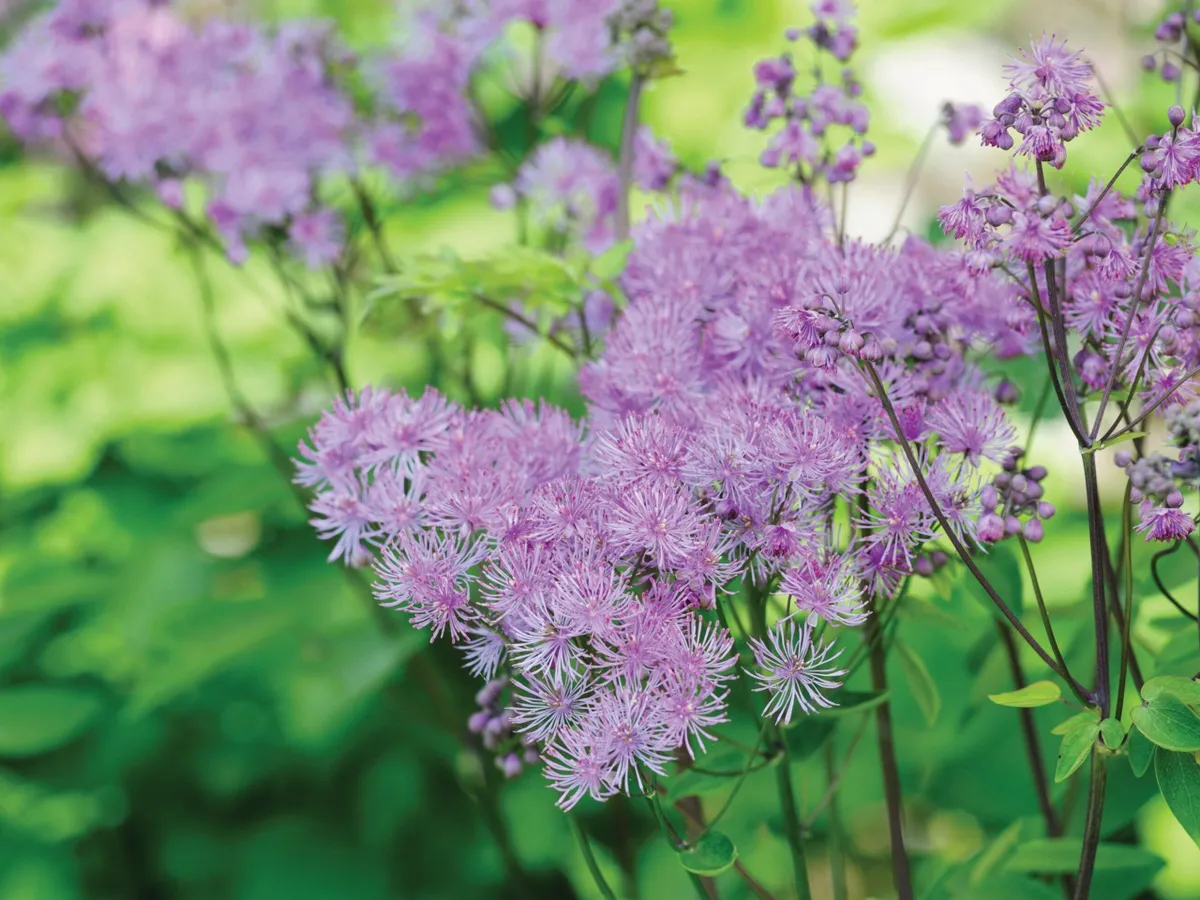
A tall and upright, hardy meadow rue with finely cut, lacey grey green foliage. Has stiff blackish stems carrying cloudy sprays of bright-purple, starry flowers at head height. Self-supporting, needing no staking; a dramatic and trouble-free perennial. Attractive seedheads follow. Seedlings are variable.
H 2m. S 50cm. PT Perennial. C Moist but well-drained soil; full sun to part shade. SI Flowers: June – July. HR RHS H7, USDA 5a-9b.
Here's more on growing and caring for thalictrum
USEFUL INFORMATION
Great Dixter House & Gardens Address Northiam, Rye, East Sussex TN31 6PH. Tel 01797 252878. Web greatdixter.co.uk Open Gardens open from March to end of October; nursery open seven days a week, April to October, and closed on Sundays from November to March. See website for opening times.